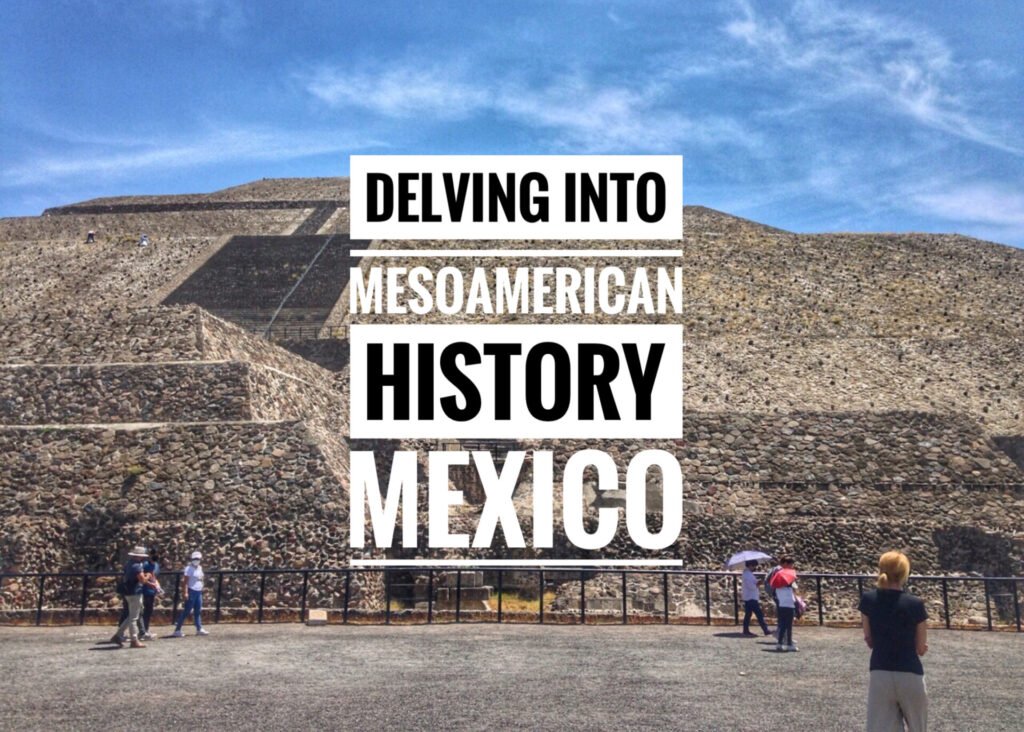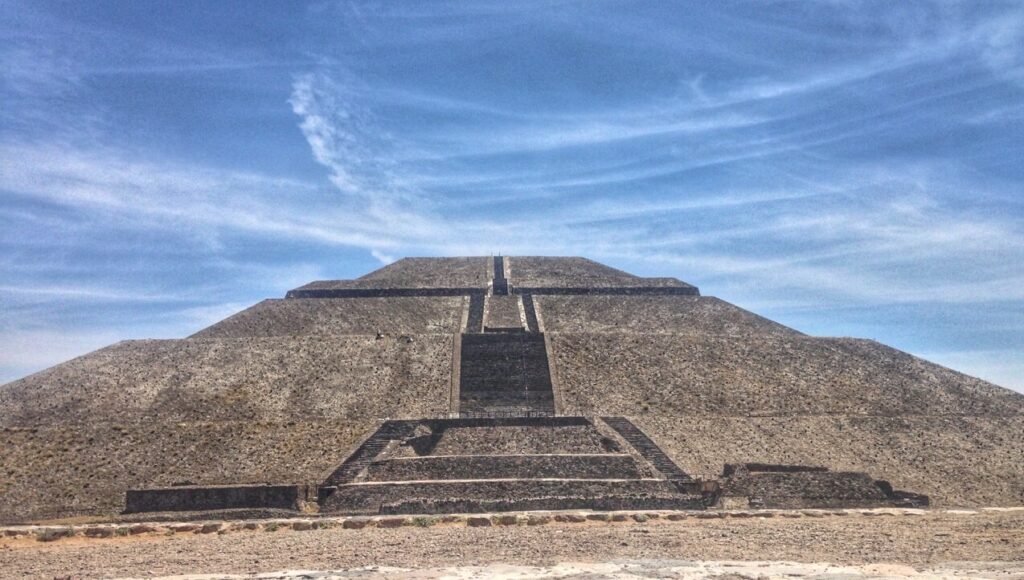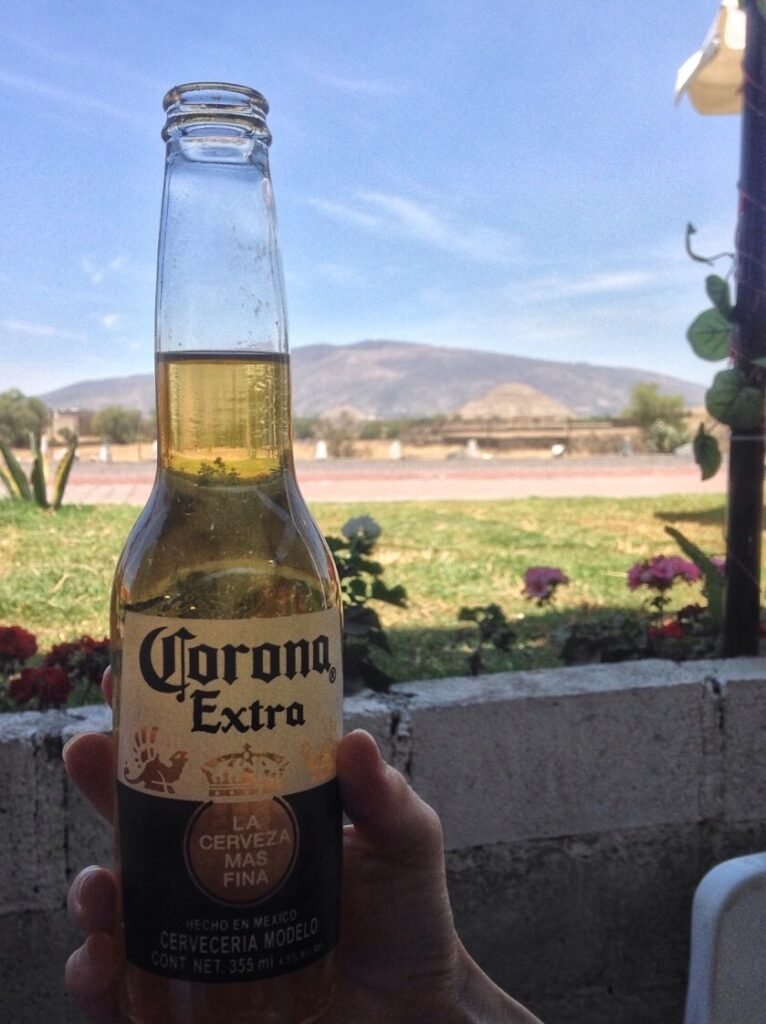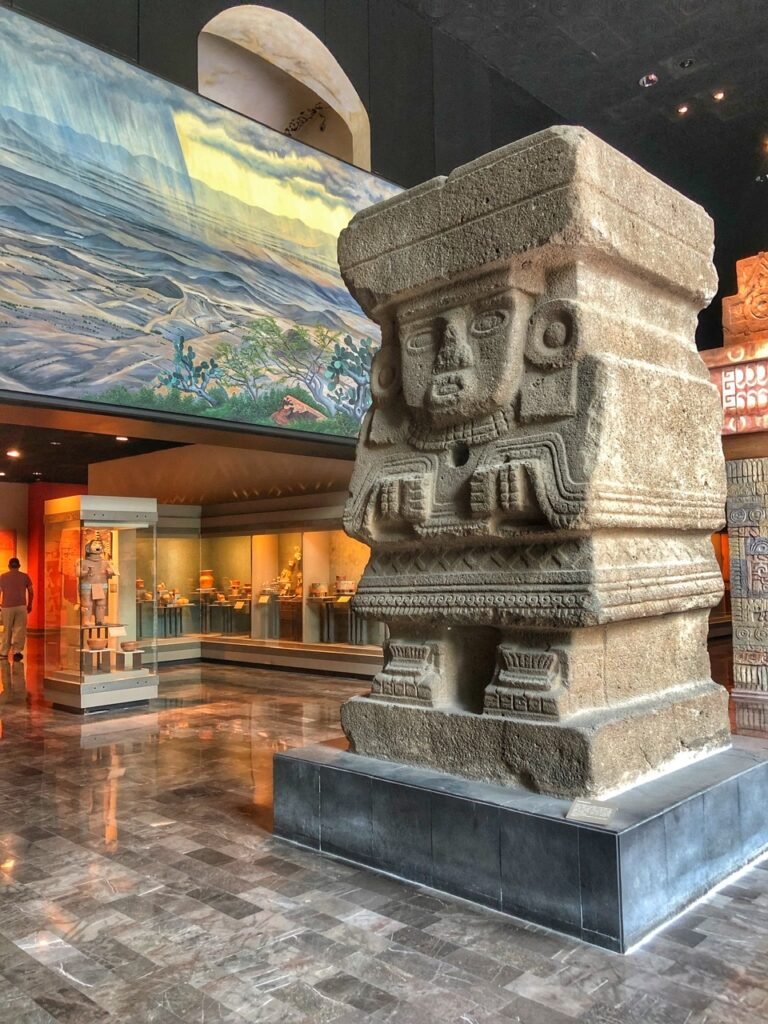
Newsflash….You don’t have to go to Egypt to see pyramids. In fact the Americas, starting with our neighbor to the south, actually contain more pyramid structures than the rest of the planet combined (more than 2000!) This is thanks to ancient civilizations like the Olmec, Maya, Aztec and Inca, which all built pyramids to house their deities, as well as to bury their kings. Mexico is littered with these jaw-dropping structures built by Mesoamerican peoples around 1000 B.C. up until the time of the Spanish conquest in the early 16th century.
Our time in Mexico City was a perfect opportunity to learn more about this complex and turbulent history, as well as the architectural marvels created during this time. We did this by visiting the great pyramids of Teotihuacan, as well as the astounding National Museum of Antropology.
Teotihuacan
Teotihuacan is an ancient Mesoamerican city 40 kilometres northeast of Mexico City. It is known today as the site of many of the most architecturally significant Mesoamerican pyramids built in the Pre-Columbia’s Americas. At its pinnacle, around 1 to 500 AD, Teotihuacan was the largest city in the pre-Columbian Americas, with a population estimated at 125,000 or more, which made it at least the sixth-largest city in the world during the time.
To get there, we took a bus from Sala 8 from the Mexico City north bus station, which we reached by metro, making this a very easy day trip. The cost is $100 pesos round trip ($5) and the cost of the entrance is $80 pesos ($4.)

Its highlight is the colossal Pyramid of the Sun, which has architectural features which prove the engineering knowledge reached by Teotihuacan’s society.
You can’t really describe how massive this pyramid is until you’re right under it. But if you need a little perspective, check out the tiny workers on the mound to the left for size perspective. At present the Pyramid of the Sun has a height of 213 feet from its base (nearly 20 stories!) Each side has a length of 746 feet at its base. It also used to be crowned with a richly ornamented temple.

Sadly we were unable to climb the pyramids like you usually can because “Covid.” ??♀️

The Avenue of the Dead was the main street of Teotihuacan. It ran for more than 2.5 km. The avenue divided the city into two sections. Apartment compounds with pyramidal constructions were arranged on both sides of the avenue, often symmetrically and sharing the same orientation. This highly planned city layout suggests that the avenue may have been planned since its early phases of urbanization.(https://shesc.asu.edu/centers/teotihuacan-research-laboratory/avenue-dead)

The Pyramid of the Moon was the little sister to the sun. It was used as a stage for performing ritual sacrifices of animals and humans. It was also a burial ground for sacrificial victims.
As you can see, it was pretty easy to socially distance at this one!

It was a bummer not to be able to climb them for the full perspective.

Walking on the Avenue of the Dead with the sun beating down on you gives you a different perspective. There were vendors trying to see trinkets scattered everywhere throughout. They were selling really nice things for as little as $20 pesos ($1). There is no question that their livelihoods have been hurt by COVID.

Speaking of COVID, grabbing lunch and a beer with a view of the pyramids. Not something you get to do everyday!
National Museum of Anthropology, Mexico City

The National Museum of Anthropology is undoubtedly a world class treasure, and is the largest and most visited museum in Mexico. (Bonus, in the springtime the Jacaranda trees flood the front entrance to the museum). We’re guessing it’s hard to find any other national museum that is entirely devoted to the archeological history of its own country, except maybe in Cairo? We enjoyed spending several hours taking in the vast history of this country from the earliest Olmec civilizations, to the Mayans, Teotihuacáns, Tulas, Mexicas (Aztecs), and up to the Spanish Inquisition.

The museum entrance. Nice and empty when we arrived upon opening (10:00.) Cost is $80 pesos or $4.

We headed first into the Teotihuacan exhibit first (which we had just visited first person a few days ago, but didn’t learn as much as we would have liked while there.) This skull with knotted bands denotes a mooring for death and sacrifice. Found in 1917 excavations in the Pyramid of the Sun and dates from 200-500s AD.) Seems like a friendly place to be!

The elaborate ornamentation of Pyramid of the Feathered Serpent was probably Teotihuacán’s most important political and religious center. In recent excavations, archeologists have discovered numerous examples of sacrificed individuals dressed as warriors buried inside the pyramid, which confirms the prevalence of human sacrifice and militarism in Teotihuacán from an early stage.


After the fall of Teotihuacan came the Tula/Toltecs which dated between AD 700-820 and it achieved its major development until the Early Post-classic (AD 900-1150). These guys mastered complex processes of craft specialization, such as the production of pottery, lithics, shell, bone, greenstone, and turquoise.
For example, this remarkable vest was recovered in the late 20th Century and is made with multiple rectangular Spondylus shell plates and finished off with snails. Obviously used by Toltec elites.

A painting depicting what is was like to build such pyramids at this time. Simply unfathomable!

This solar disc linked the Toltecs with the war, as they were part of the military clothing. It is possible the disk has embodied some warlike or solar power, since the center of the pyrite disk had the ability to reflect light, although it is now degraded. It is made of 300 turquoise plates mounted on a wooden base (Early Postclassic, 900-1250 AD)

Moving on, we checked out the Mexica civilization (which later became the Aztecs) which is how Mexico City was founded. Its original name was called Tenochtitlán and was founded in 1325 A.D. by the Mexicas. The Mexicas believed that their god would show them where to build a great city by providing a sign, an eagle eating a snake while perched atop a cactus. (This is why this symbol is slapped on the Mexican flag today.) When the Mexicas saw the vision come true on an island in Lake Texcoco, they astonishingly filled in the lake to begin creating what became the largest and most powerful city in pre-Columbian America and is now the fifth biggest city on earth at 22 million (depends on what source you read.)

The entrance to the Mexica wing.

Most people don’t know that ancient civilizations of Mexico were significantly into sports. For the Mexicas, the sacred ball game was ullamaliztli, a word derived from rubber, which was the material used to make the ball which was skillfully moved by the players, obtaining a precise bounce which surprised the European conquerors. The game was played on a special court called a tlaxco, which was a field in a unique shape, like an “I.” On either side there were slopes and walls where the stone rings like these were placed, one to the south and one to the north, through which the balls had to pass when struck either with the hips or the forearm. (You weren’t allowed to use hands or feet!)

Shortly after the Spanish Conquest, the monolithic Stone of the Sun sculpture was buried in the Zocalo, the main square in Mexico City, and was rediscovered in 1790 during repairs on the cathedral. Following its rediscovery, the sun stone was mounted on an exterior wall of the cathedral, where it remained until 1885. Modern research suggests that it was carved some time between 1502 and 1521 and there are no clear indications about the authorship or purpose of the monolith.

A large scale model of what a market might have looked like back then at the Market of Tlatelolco. According to the conqueror Hernán Cortés, more than 30,000 natives met daily to exchange their products. The market as a whole consisted of a large open-air space, like a patio, surrounded by rooms that served as warehouses. It’s kind of astounding to look at because it’s not much different than other modern day markets we’ve seen around the world.

A “dictionary” communicating a pictorial language into a tribal language, into Spanish. Kinda cool.

Next we stepped back into to the Olmec civilization, or the first civilization in ancient Mexico and one of the first on the American continent which formed on the Gulf Coast. Its development has been dated between 1800 and 200 B.C.
The Olmec were gifted artists who produced stone carvings, woodcarvings and cave paintings. Their most notable creation was the massive heads, carved from a single basalt boulder.

Chacmool, a very famous Mayan artifact. Aztec chacmools bore water imagery and were associated with Tlaloc, considered the rain god. Their symbolism placed them on the frontier between the physical and supernatural realms, as intermediaries with the gods. The chacmool form of sculpture first appeared around the 9th century AD in the Valley of Mexico. (Wikipedia)

A replica of Bonampak, which still exists in the jungle near the Mexico/Guatemala border. We hope to get there one day.

A replica of the Tomb of the Red Queen at Palenque, which contains the ruins of Lady Ix Tz’akbu Ajaw, who with her husband, transform Palenque into a powerful kingdom. Discovered buried deep within Temple XIII in 1994, this is one of the most important finds at the ancient Maya city and is where one of the few burials found in Mesoamerica where the deceased was interred in a sarcophagus. Greg was lucky enough to see this in 1998, but they have since closed it to the public.
Outside of the museum, there is another site to send your peepers to…the hourly rendition of Danza de Los Voladores. The Danza de Los Voladores is an ancient Mesoamerican ritual, which is believe to have originated with the Otomi, Huastec and Nahua people in Central Mexico.
The ritual consists of dance and the climbing of a 30-meter pole from which four of the five participants then launch themselves tied with ropes around just one ankle to swing themselves gracefully to the ground. The fifth person remains on top of the pole, dancing and playing the flute and drum. According to one myth, the ritual was created to ask the gods to end a severe drought. Although there were only four dancers the day we saw it in Chapultepec Park, it seems like they improvised quite well with one fo the hanging men playing the flute and drum as he twirled. That’s some serious talent and dedication.



